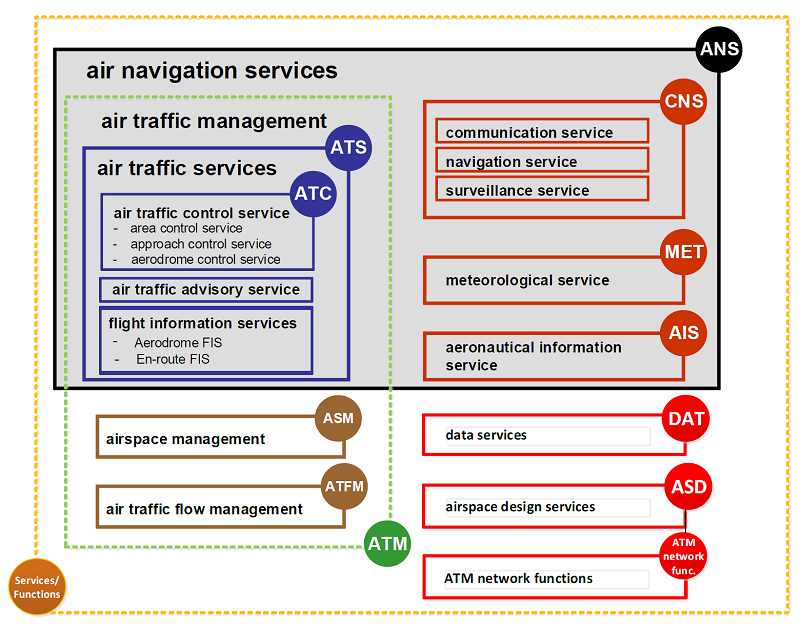Which ATM/ANS providers fall under the EASA Basic Regulation and its implementing rules?
The services included in the definition of ATM/ANS are schematically represented in the picture below.

What are the main regulations governing ATM/ANS?
The main regulations governing ATM/ANS are the Basic Regulation 2018/1139 and the Single European Sky framework package, consisting of:
- Regulation (EC) No 549/2004 of the European Parliament and of the Council of 10 March 2004 laying down the framework for the creation of the single European sky (the framework Regulation);
- Regulation (EC) No 550/2004 of the European Parliament and of the Council of 10 March 2004 on the provision of air navigation services in the single European sky (the service provision Regulation);
- Regulation (EC) No 551/2004 of the European Parliament and of the Council of 10 March 2004 on the organisation and use of the airspace in the single European sky (the airspace Regulation); and
- Regulation (EC) No 552/2004 of the European Parliament and of the Council of 10 March 2004 on the interoperability of the European Air Traffic Management network (the interoperability Regulation).
- Amended by Regulation (EC) No 1070/2009 of the European Parliament and of the Council of 21 October 2009 amending Regulations (EC) No 549/2004, (EC) No 550/2004, (EC) No 551/2004 and (EC) No 552/2004 in order to improve the performance and sustainability of the European aviation system.
It shall be noted that COMMISSION IMPLEMENTING REGULATION (EU) 2017/373 of 1 March 2017 laying down common requirements for providers of air traffic management/air navigation services and other air traffic management network functions and their oversight is an implementing rule to both SES Regulations and EASA Basic Regulation.
COMMISSION IMPLEMENTING REGULATION (EU) No 1035/2011 of 17 October 2011 laying down common requirements for the provision of air navigation services; and
COMMISSION IMPLEMENTING REGULATION (EU) No 1034/2011 of 17 October 2011 on safety oversight in air traffic management and air navigation services;
Note: Implementing Regulations (EU) No 1034/2011 and (EU) No 1035/2011 will be repealed as from 2nd January 2020 (Applicability Date of Regulation (EU) 2017/373).
What is the difference between ATM and ATC?
According to Definitions in Article 2(1) and (10) of Regulation (EC) No 549/2004 of the European Parliament and of the Council of 10 March 2004 laying down the framework for the creation of the single European sky.
‘Air traffic control (ATC) service’ means a service provided for the purpose of:
(a) preventing collisions: — between aircraft, and — in the manoeuvring area between aircraft and obstructions; and
(b) expediting and maintaining an orderly flow of air traffic;
‘Air traffic management (ATM)’ means the aggregation of the airborne and ground-based functions (air traffic services, airspace management and air traffic flow management) required to ensure the safe and efficient movement of aircraft during all phases of operations;
Is ATM/ANS personnel covered by Regulation (EU) 2017/373?
ATSEP – Air Traffic Safety Electronics Personnel are covered. Those can be found in Annex XIII – Part – PERS of Regulation (EU) 2017/373.
However, there is a general requirement in Annex III of Regulation (EU) 2017/373:
ATM/ANS.OR.B.005 Management system
A service provider shall implement and maintain a management system that includes:
(…)
(a)(6) a process to ensure that the personnel of the service provider are trained and competent to perform their duties in a safe, efficient, continuous and sustainable manner. In this context, the service provider shall establish policies for the recruitments and training of its personnel;
Who is the ATM/ANS Competent Authority in my country?
The competent authority responsible for the issuing of certificates to service providers, for the acknowledgment of receipts of declarations made by providers of flight information services where relevant, and for the oversight and enforcement in respect of service providers shall be the national supervisory authority.
Who is the competent authority for ATM/ANS Pan-European services?
According to Article 2 (Definitions) of Regulation (EU) 2017/373:
‘Pan-European service’ means an activity which is designed and established for users within most or all Member States and which may also extend beyond the airspace of the territory to which the Treaty applies.
The competent authority with regard to Pan-European services (e.g. DAT providers, the Network Manager, etc.) shall be the Agency (EASA) as defined in Article 4(1) of Regulation (EU) 2017/373.
What are Air Navigation Services (ANS) according to EASA?
"Air Navigation Services" means air traffic services; communication, navigation and surveillance services; meteorological services for air navigation; and aeronautical information services. (Article 2(4) of Regulation (EC) No 549/2004 of the European Parliament and of the Council of 10 March 2004 laying down the framework for the creation of the single European sky.)